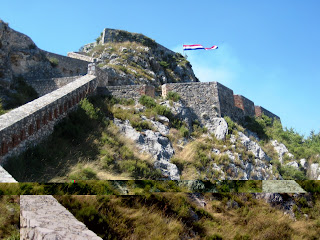As we see Autumn coming to a close in Sibenik, we can reflect on the gorgeous colour palettes of oranges, reds, yellows and browns, signalling that winter is approaching. The nights are now quite cool, but the fresh and often clear days lend themselves to the ideal time for exploring the natural and archeological wonders that our region is blessed with.
One of our favourite things to do is hiking. The landscape is like a wilderness untouched and uspoilt in its natural wonder. There is an ever-changing and breathtaking beauty to be discovered, as if for the first time.
One of our favourite things to do is hiking. The landscape is like a wilderness untouched and uspoilt in its natural wonder. There is an ever-changing and breathtaking beauty to be discovered, as if for the first time.
Expect to see spectacular waterfalls, rivers, flora, fauna and a uniquely magnificent landscape that can only occur in this uniquely karstic natural wonder, meaning that the area is characterised by limestone and also includes the formation of the most incredible natural sights such as canyons, sinkholes, underground streams and caverns. Such is the beauty of the whole of Dalmatia from the hinterland all the way to the coast.
We are extremely fortunate to personally know one the best and most experienced hiking guides in Croatia, our good friend Jozo. He has over 20 years experience trekking the Dalmatian hinterland, some areas little explored and some sights unheard of even by locals.
The following will give you an idea of the kind of guided tours we can arrange for you:
Mt Dinara climb, this is Croatia's highest mountain at 1831 metres.
Mt Dinara climb, this is Croatia's highest mountain at 1831 metres.
Zrmanja and Krupa Rivers hike, incuding canyons, caves, waterfall, underground spring, ancient monastery and stone bridge.
Cikola River canyoning, including caves, waterfalls, meeting the Krka River and the medieval Kljucica fortress
Surdup climb, via Knin in the Mt Dinara region, near the Bosnian border. Knin - important to Croatia's history and known as the 'home of Croatian kings' as it was the capital of the Kingdom of Croatia a thousand years ago - is host to historical and medieval fortifications, it is the site of prehistoric remains as well as the point where the Krcic and Krka rivers join.
NP Krka hike, to the best vantage points for picturesque scenery of rivers, fortresses and waterfalls.
Aside from exploring by foot the various fortresses in the Sibenik region, and trekking through natural terrain filled with spectacular scenery, or visiting prehistoric and archeological sites, why not consider jeep safari tours? These are available to Vranjsko Lake, Krka, Primosten and Mt Dinara.
There are many options for active, adventure style experiences that allow you to enjoy the natural beauty of Croatia; diving, caving, canoeing, kayaking, rafting, sailing, mountaineering and rock climbing, recreational and game fishing, para-gliding, cycling and mountain biking and horse riding.
Other outdoor ventures include golf, and in our very own Sibenik there's paint ball, bungee jumping, and a falconry centre.
Email: info.HolidaysCroatia@gmail.comPublish Post
http://holidaycroatia.blogspot.com/2010/11/hiking-in-dalmatia-at-one-with-nature.html
Aside from exploring by foot the various fortresses in the Sibenik region, and trekking through natural terrain filled with spectacular scenery, or visiting prehistoric and archeological sites, why not consider jeep safari tours? These are available to Vranjsko Lake, Krka, Primosten and Mt Dinara.
There are many options for active, adventure style experiences that allow you to enjoy the natural beauty of Croatia; diving, caving, canoeing, kayaking, rafting, sailing, mountaineering and rock climbing, recreational and game fishing, para-gliding, cycling and mountain biking and horse riding.
Other outdoor ventures include golf, and in our very own Sibenik there's paint ball, bungee jumping, and a falconry centre.
Email: info.HolidaysCroatia@gmail.comPublish Post
http://holidaycroatia.blogspot.com/2010/11/hiking-in-dalmatia-at-one-with-nature.html

























































